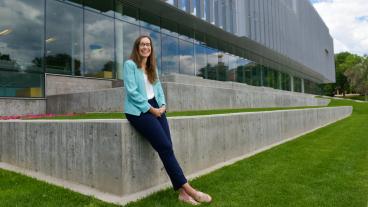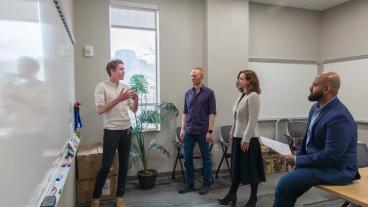 A trio of Colorado School of Mines professors are lending their expertise to a multimillion-dollar U.S. Department of Energy geothermal project that’s aiming to remove the technical barriers to commercializing the clean energy source.
A trio of Colorado School of Mines professors are lending their expertise to a multimillion-dollar U.S. Department of Energy geothermal project that’s aiming to remove the technical barriers to commercializing the clean energy source.
The Lawrence Berkeley National Laboratory is leading seven other DOE national laboratories and six universities on the EGS Collab Sigma-V Project. Locally, the partnership includes Mines and the National Renewable Energy Laboratory in Golden.
Three faculty members from Mines’ Petroleum Engineering Department are contributing to the project: Associate Professor and Associate Department Head Jennifer Miskimins, Professor Yu-Shu Wu and Research Associate Professor Philip Winterfeld. All three are collaborating with NREL.
Together, researchers plan to develop field experiments to improve understanding and modeling of rock fractures, an essential part of geothermal systems. Those experiments will occur 1,500 meters underground at the Sanford Underground Research Facility in South Dakota.
“The work that we’re doing at Mines with NREL will help further the understanding of the hydraulic fracture growth processes that are used in enhanced geothermal systems,” Miskimins said. “Such advancements will help with supporting the commercial viability of EGS.”
 Miskimins and a student will be doing fracture simulation work to help design the fracturing treatment that will be used at the experimental site. Wu and Winterfeld are focusing on thermal-hydraulic-mechanical-chemical (THMC) modeling and feature characterization.
Miskimins and a student will be doing fracture simulation work to help design the fracturing treatment that will be used at the experimental site. Wu and Winterfeld are focusing on thermal-hydraulic-mechanical-chemical (THMC) modeling and feature characterization.
Other national labs participating in the project are Sandia, Lawrence Livermore, Idaho, Los Alamos, Pacific Northwest and Oak Ridge. On the university side, professors from Stanford University, University of Wisconsin, South Dakota School of Mines and Technology, Penn State University and University of Oklahoma are also contributing.
EGS Collab has been awarded $9 million for the first year by DOE’s Geothermal Technologies Office. The original multi-institution proposal was submitted in late 2016 and approved in early 2017 for three years.
Enhanced geothermal systems could eventually provide more than 100 gigawatts of electric generating capacity in the United States, according to the Berkeley Lab. That's substantially more than the current capacity of 3.5 GW.
 Geothermal systems work by taking heat acquired from water circulating in rock fractures deep underground and converting it into electricity.
Geothermal systems work by taking heat acquired from water circulating in rock fractures deep underground and converting it into electricity.
Traditional geothermal systems, though, are only viable in areas with specific geological characteristics. Heat, fluid and permeability—the measure of how easily fluid can circulate through rock fractures and thus pick up heat as it moves—are essential.
By enhancing or engineering the fracture network, though, EGS could bypass traditional geographic limitations, making it a viable clean energy source in more places.
The knowledge gained from EGS Collab will also feed into DOE’s flagship geothermal project, the Frontier Observatory for Research in Geothermal Energy (FORGE). FORGE aims to enable cutting-edge research and drilling and technology testing while allowing scientists to identify a replicable, commercial pathway to EGS.
Photo credit: Matthew Kapust, Sanford Underground Research Facility
CONTACT
Emilie Rusch, Public Information Specialist, Communications and Marketing | 303-273-3361 | erusch@mines.edu
Mark Ramirez, Managing Editor, Communications and Marketing | 303-273-3088 | ramirez@mines.edu



